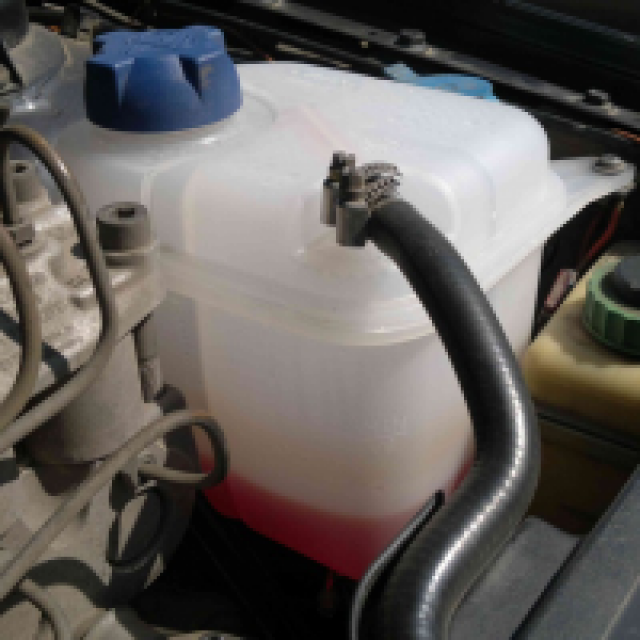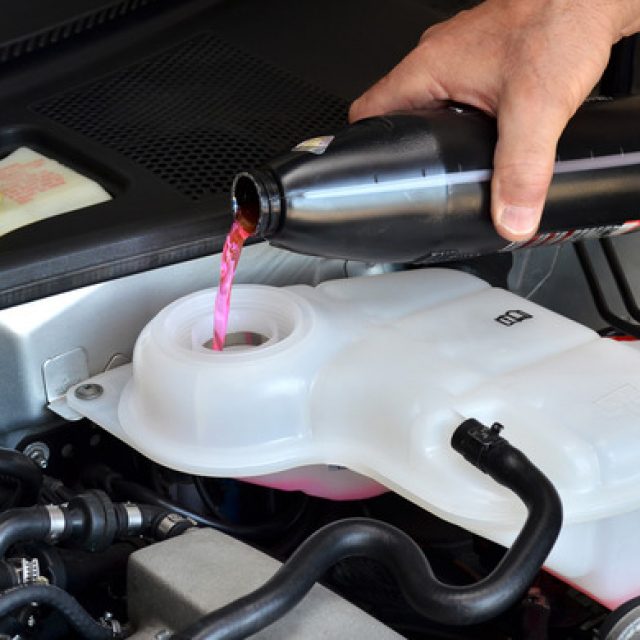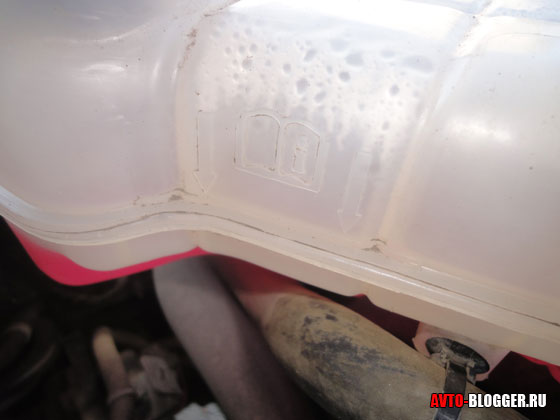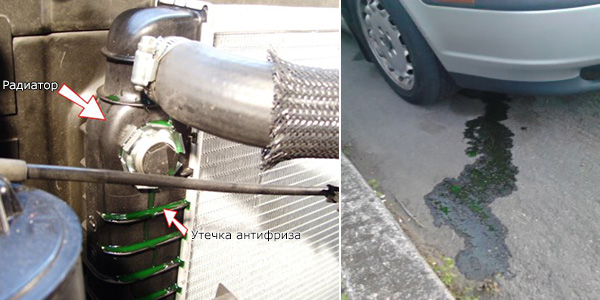Antifreeze level is the volume of coolant poured into the car’s cooling system.
A low level of antifreeze will lead to overheating of the engine, increased load, and rapid wear of engine parts. High level It is not recommended to use antifreeze - there will be high pressure in the car's cooling system.
Caring for the condition of a car engine comes down to checking the antifreeze level!
How to check the antifreeze level? Expansion tank.
The antifreeze level is checked visually in the expansion tank.
The expansion tank of the machine has two antifreeze marks - minimum and maximum. When checking the level of height, make sure that the antifreeze mark is not lower than the minimum mark on the reservoir. The ideal antifreeze height point is the middle between the marks. In addition, the engine temperature affects the expansion tank mark readings.
The antifreeze height should be checked on a warm engine at operating temperature (90 degrees).
Low fluid level - why?
A low antifreeze level indicates problems:

1. Antifreeze leaks from the system.
2. The car engine is cold. On a cold engine, the antifreeze level is below the standard value.
In the first case, you should immediately contact a car service indicating the problem. The technician will inspect all fluid pipes, hoses, thermostat, radiator, expansion tank, car pumps - to identify the cause of fluid leakage.
The antifreeze mark is low when the cylinder head gasket (G-B-C) burns out. The gasket burns out when the engine overheats, antifreeze enters the combustion chamber and the car's oil.
Operating a machine with a low antifreeze level is strictly prohibited!
What mark should be in the system?
The ideal antifreeze mark is the middle of the expansion tank.

If necessary, add antifreeze to the system to the middle of the mark. Only add the antifreeze that is currently used in the car.
If there is no antifreeze in the expansion tank, it is prohibited to operate the car!
Does the antifreeze height rise sharply? 7 cases and reasons!
7 cases of sudden rise in antifreeze:
1. The engine is started.
2. The engine is warmed up to operating temperature.
3. Present in the system airlock- air accumulates near the thermostat, creating increased pressure.
4. Thermostat failure - antifreeze circulates in a small circle, creating increased pressure
5. Malfunction of the antifreeze pump.
6. Micro crack in the cylinder head.
7. The block gasket is broken. Inspect the car's oil dipstick; there should be no drops of antifreeze.
- The solution to the problem with a sharp rise in antifreeze height of 90% is to remove the cylinder head.
Antifreeze, also known as coolant, plays a key role in the proper functioning of the car. Its main task, as the name suggests, is to cool the engine. If there is not enough antifreeze in the tank, there is a high risk that the car. This is fraught with many problems for the engine at once, so such a problem cannot be allowed. The driver is obliged to monitor the level of antifreeze in his car, and in this article we will look at how to do this correctly.
How to check the coolant level
 The reservoir into which the coolant is filled is located under the hood. Every driver can easily find it, since such a tank is often very spacious. Accordingly, it is necessary to control the level of antifreeze in this tank, but it is important to do it correctly.
The reservoir into which the coolant is filled is located under the hood. Every driver can easily find it, since such a tank is often very spacious. Accordingly, it is necessary to control the level of antifreeze in this tank, but it is important to do it correctly.
Please note: Nowadays all car manufacturers use closed radiators. Whereas previously there were plugs on the radiators that could be unscrewed to see the coolant level.
Checking the coolant level is extremely simple - just look at the expansion tank and analyze how much liquid is in it. But here you need to know some rules:
- You should only check the coolant level on a cold engine, since only when the engine is at rest is all the antifreeze in the tank;
- There are special marks on the tanks of almost all modern cars, according to which the amount of coolant should be monitored. Most often, there are two such marks - MAX and MIN, that is, the maximum and minimum permissible levels of antifreeze for proper operation of the car engine.
 Please note: If there are no marks on the expansion tank of your carMAX andMIN, the principle should be that coolant should be filled to half the tank. If the expansion tank is located inconveniently, in order to determine exactly how much liquid is currently inside the tank, you can use a regular stick to control the amount of liquid along its length.
Please note: If there are no marks on the expansion tank of your carMAX andMIN, the principle should be that coolant should be filled to half the tank. If the expansion tank is located inconveniently, in order to determine exactly how much liquid is currently inside the tank, you can use a regular stick to control the amount of liquid along its length.
There are situations when the expansion tank of a car has only one inscription -MAX orMIN. In this situation, you should be guided by the basic principles:
- The amount of coolant in the vehicle should never fall below the MIN mark;
- If it is not possible to determine the MIN mark, then the amount of antifreeze in the expansion tank should not fall below 1 cm from the MAX value.
Remember that both an insufficient amount of antifreeze in the expansion tank and an excessive amount are dangerous. If there is not enough coolant, the engine runs the risk of overheating, which can lead to serious consequences, including the need for major repairs. If there is a lot of coolant, there is a high risk that during the movement, when the liquid begins to expand under heat, the reservoir cap will be knocked out.
How often to check the antifreeze level
 Since it is not possible to determine the coolant level using readings on the dashboard or on-board computer in every car model, many drivers forget about the need to monitor the antifreeze level.
Since it is not possible to determine the coolant level using readings on the dashboard or on-board computer in every car model, many drivers forget about the need to monitor the antifreeze level.
To avoid the risks associated with insufficient antifreeze in the engine, it is recommended to check its level at least once a week.
Coolant is a very important component in any car - it prevents the engine from overheating. Therefore, the liquid must be present all the time a certain level, otherwise, if the fluid level drops, then it may not be far from serious damage! Every week you need to monitor the coolant level (), and this is very easy to do...
Nowadays, almost all modern car radiators are closed, that is, they do not have plugs that you can unscrew and see the level of antifreeze or antifreeze (this was the case on older radiator models). Now the level is controlled entirely through the car's expansion tank. Also, coolant must be poured into this tank.
So, checking the level is very simple, just look at the tank!
![]()

Special marks are marked on the tank, usually a minimum mark (marked on the tank as “MIN”) and a maximum mark (marked on the tank as “MAX”).

It also happens that there are no such marks, but there is only one working maximum level. How to look at my photos.


The antifreeze or antifreeze level should be slightly below the “MAX” level (by 1 cm) or correspond to it. This level should be on a cold engine.
Under no circumstances should you overfill the maximum level, because when the engine is running, the liquid expands and will simply damage your expansion tank. Usually the cork suffers - it gets knocked out.
Also, the minimum level (mark “MIN”) or a completely empty tank should not be allowed. The engine does not cool down, and therefore the engine will simply overheat, which is fatal for it.
Ideally, the level should be between the MIN and MAX marks, but should be close to the maximum.
It also happens that there are no marks on the tank, or the tank is generally closed so that you can’t get to it. How then to determine the level and how much fluid to fill?
It’s also simple, there should be about half a tank of liquid! If you cannot determine how much liquid is in the slightly open cap (not visible from the sides), then simply insert a clean stick into the tank, determine the depth of the tank and then fill exactly half of the stick.
Now a short video.
This is how it is easy and simple to determine the level of coolant (antifreeze and antifreeze).
That's all, read our AUTOBLOG.
The list of works on maintenance of the vehicle includes checking the level of working fluids of the power plant and other components of the vehicle. For different liquids, testing is carried out at certain intervals or after a certain period of time.
Why do you need to check antifreeze?
It is recommended to check the car's coolant level twice a year - before the start of the summer and winter seasons. But this recommendation is somewhat incorrect, because the cooling system performs a very important function - maintaining optimal temperature regime power plant. If there is not enough antifreeze, this is fraught with very serious problems. Therefore, it is better to check the coolant level every time you open the hood of the car, since this operation is simple and takes a couple of minutes.
Checking the level every time the owner looks into the engine compartment almost completely eliminates missing the moment when there is not enough antifreeze in the system. A reason to check the fluid level in the cooling system may also be an increased engine temperature while driving.
How to check correctly?
Now about how to check the antifreeze level. Cooling systems in different cars are slightly different; some have an expansion tank that controls the level, while others do not.
In cars whose cooling system includes this reservoir, checking the level is very simple. The tank is usually made of light plastic, and the antifreeze has a certain color. There are also marks on the tank wall indicating the minimum and maximum levels. Therefore, to check the fluid level, you don’t even need to unscrew the cap; you just need to look at the level on the wall of the tank and compare it with the marks.
In cars whose cooling system does not include a tank, topping up and level control is done through the neck located on the radiator. That is, we unscrew the radiator cap and look at the level.
Now some features of the test. It is performed only on a cold and idle engine, for a number of reasons. When heated, antifreeze expands, so when monitoring the level in the tank, the quantity data will be incorrect.
As for cars in which the fluid is checked in the radiator, checking when the engine is hot can lead to injury. The fact is that after heating, pressure forms in the system, and if you remove the radiator cap, there is a high probability of hot antifreeze splashing out through the neck, so it is very easy to get burned. It is best to check the level in the morning, before the trip. The engine will cool down completely overnight, and the level readings will be most accurate.
How much antifreeze should there be?
If you check the tank, then the optimal level will be between the “Min” and “Max” marks. If the fluid is at the “Min” level or below, the power plant will not have enough fluid even after heating and expansion. Air may be sucked into the system, which, after heating, will only increase the pressure in the system, causing the engine temperature to be elevated and possibly squeezing out the liquid from the reservoir or causing one of the system pipes to break off. But if the level is at “Max” or higher, then after heating the excess antifreeze will simply flow out of the tank.
In those cars where antifreeze is poured into the radiator, there is also a mark on the neck, but this only indicates normal level. It is usually located at the bottom of the neck. This is where you need to navigate.
A low level of liquid in the cooling system carries the risk of: increased temperature of the power plant and its overheating, increased pressure in the system when heated, and the possibility of splashing due to air entering the system.
Probable leak locations
Where can antifreeze go? It is still a liquid, so it can evaporate when heated. To make evaporation less intense, the tank or radiator is tightly closed with a lid. But complete blockage is also not allowed, so there are bypass valves in the lid.
They are needed to relieve pressure in the system if it has risen above the critical norm. It is through this valve that antifreeze evaporates, especially in the summer season. It is very hot in summer, and if you drive in a traffic jam, the cooling system will not have time to fully remove heat from the engine; it will work at elevated temperature. In this case, the antifreeze heats up more than normal, part of it goes into a gaseous state (steam), increasing the pressure in the system, and when the pressure rises above normal, the steam will be released through the valve.
Antifreeze may also leak due to a leak in the system or a crack in one of the rubber pipes. Because of this, the coolant will simply leak out through a leak or crack. In this case, it is very easy to detect a leak - by drips on the pipes and traces of liquid on the asphalt under the car while parked. 
The most unpleasant leak is due to a breakdown of the cylinder head gasket (cylinder head). As a result of the breakdown, the cooling system channel is connected to the cylinder, or the crack leads outward. It is very dangerous if a breakdown connects the channel to the cylinder. Not only will the liquid “fly out into the pipe” in the literal sense, but if the repair is untimely, a “water hammer” may occur due to the large amount of antifreeze in the cylinder, and this is already fraught with serious problems, since as a result of this effect the destruction of the piston is possible, connecting rod bend.
It is noteworthy that a cylinder head gasket failure is usually a consequence of engine overheating due to insufficient antifreeze.

What and how much should I add?
Finally, about what kind and how to add antifreeze. It is necessary to top up only when the engine is cooled down in order to know the level accurately; when it is heated due to expansion, it will not be possible to accurately determine the level. It is necessary to top up to the mark in the radiator, and if there is none, then almost to the edge of the neck; the excess will be squeezed out through the cap when heated. The tank is topped up to the level located between the marks. 
Only the antifreeze that is filled should be poured into the system. Mixing different types antifreeze is not allowed. If you don’t have liquid on hand to top up, you can use distilled or plain clean water. But it is important to take into account that adding water will significantly reduce the freezing threshold of antifreeze, so you can add it only in the summer, and before the winter period, completely change the fluid in the system.
We looked at how to check the coolant level, how to add antifreeze, and what problems a lack of it in the system can cause. If you periodically monitor the level and, if necessary, replenish it, the cooling system will not fail at the most inopportune moment and will ensure the optimal temperature of the power plant.
The characteristics of the vehicle correspond to the declared parameters only if the conditions of use are met. One of the most important factors for preserving the life of the engine and other vehicle systems is maintaining temperature conditions.
At the first signs of deviations from the norm, you should contact specialists, or, with appropriate qualifications, correct the problems yourself.
Why is verification needed?
Temperature fluctuations can be quite significant and in practice the difference sometimes reaches 150° C. For example, if the engine housing in operating mode heats up to +110° C, and the air outside is 40° C. Naturally, water is not suitable for these purposes, but cooling the liquid has the required characteristics.
Timely checking of its level is one of the basic criteria when servicing a car. It is necessary to provide the following parameters:
- Security. Overheating can cause unexpected breakdowns while driving, which can lead to extremely undesirable consequences.
- Economical. This procedure will save the car owner from expensive repairs caused by premature wear of car parts and components.
- Reliability. In winter, operating a modern car is impossible without antifreeze. An insufficient level of this liquid is extremely dangerous; it is no coincidence that the literal translation from English of this concept means “non-freezing”.
You can check the coolant level every time there is a reason to open the hood. It is recommended to regularly monitor its quantity, at least 2 times a year. A complete fluid change is done every 2-3 years.
What affects the coolant level?
The required amount of antifreeze keeps the vehicle systems in optimal condition. The characteristics declared by the manufacturer are achievable only at the recommended coolant level and directly affect the following parameters:
- Boiling point. The calculated value is about 110° C. It is not recommended to warm up the engine above this value. The cooling system is designed in such a way that the continuous flow of coolant in a circle through the radiator and the power unit duct system maintains a temperature balance from 60° C to 108° C.
- Engine starting. During the cold season, it is important that the antifreeze is mobile in the system. Water at temperatures below zero turns into ice, and the route of its movement in this case will be blocked, which will lead to overheating of the engine. Antifreeze and antifreeze, depending on the brand, do not freeze at temperatures down to -65° C. In most cases, the service life of coolant rated up to -40° C is sufficient;
- Job hydraulic system transmissions. In many modern cars with automatic transmission, it is necessary to maintain optimal temperature in the transmission. Coolant in this case is the most effective solution to the problem.
- Additives and additives in the composition of coolant. They give it additional qualities, and this, first of all, affects its anti-corrosion properties. In addition, the balanced composition prevents the formation of scale and has a lubricating effect.
How much antifreeze should there be?
 The functions performed by the coolant are important in both summer and winter, so regular inspection of the system is an urgent need. The lack or substandard quality of this fluid depletes the engine's life, and in some cases, leads to breakdown and, as a result, to expensive and troublesome repairs.
The functions performed by the coolant are important in both summer and winter, so regular inspection of the system is an urgent need. The lack or substandard quality of this fluid depletes the engine's life, and in some cases, leads to breakdown and, as a result, to expensive and troublesome repairs.
You can check the status of the system in absolutely any car. This is not a difficult task, since machine manufacturers provide unhindered access to the control device.
Exact information about the volume of coolant for a specific model is indicated in the car's passport. It is also easy to find in specialized tables on thematic websites or by consulting with a mechanic or sales manager.
It is important to remember this rule: mixing antifreezes of different compositions is not recommended.
You need to know the brand of your coolant, and in all doubtful cases, contact a specialist. Otherwise, you will have to do a complete fluid change.
If, for example, blue antifreeze is filled, then you cannot add red.
But you shouldn’t focus only on color either. Different manufacturers use their own exclusive developments, but no one can guarantee the compatibility of ingredients with the same color.
Checking the antifreeze level
The need to control the cooling system does not raise questions, but how can this be done in practice?
Today there are two main methods for checking the coolant level:

Having unscrewed the sensor, inspect its working part. Usually this is a cylinder white, which should contain traces of antifreeze. If the device is dry, then you need to add antifreeze and change the sensor.
Add coolant
The procedure for adding coolant is not difficult. However, this should not be done with the engine just turned off. The car is allowed to cool for some time. The filling location is indicated in the manual. If you don’t have it at hand, then you need to consult with specialists.
The sequence of operations is as follows:
- open the hood;
- we find the expansion tank and inspect it, determining the fluid level relative to the marks;
- After making sure that the engine has cooled down, carefully unscrew the cap. The difference in pressure can be significant, so you need to open the tank carefully, without rushing. Having made sure that the hissing has stopped under the lid, feel free to unscrew it completely;
- Wearing gloves, open the container with the desired brand of antifreeze or antifreeze;
- add coolant to the required level;
- screw the cap of the expansion tank tightly.
In some older models, coolant is added directly to the radiator, and its level is determined with a dipstick. In modern cars, the expansion tank is clearly visible. Any adequate car owner can add antifreeze to the middle position between the “MAX” and “MIN” marks.




